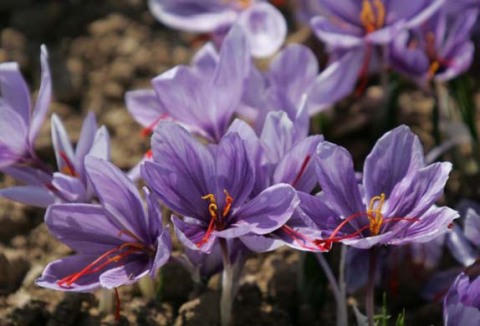Saffron, the most expensive spice existing on the market is actually the flower of a species of Crocus called Crocus sativus and it is native to Southwest Asia. Being a part of the family Iridaceae, Crocus sativus or more exactly, its flower, is widely known for its use not only in cooking but also in the textile industry because of the coloring agents it contains.
With a name borrowed from Latin and meaning yellow, Saffron has a bitter taste and when used, it manages to give either to meals or textiles, a pleasant golden-yellow color that makes it easy to recognize.
Crocus sativus or Saffron crocus is a perennial plant having autumn as blooming period. The flowers have the same colors but the nuances may differ, meaning that some of the plants have a pastel shade of liliac and others may reach a darker mauve that manages to underline the most important part of the Crocus sativus, and that is the stigma. Considering the fact that this plant, even though it produces seeds, it is a sterile plant, the propagation process may be done only by corms.  Saffron flowers are ready for picking on a farm in Shahn Abad village, near the town of Torbat-e Heydarieh, northeast of Iran, 31 October 2006. Despite Iran’s status as the undisputed heavyweight champion of the saffron world, it has yet to realize the full economic potential of the 3,000 year-old industry and faces challenges to hold on to its rampant market share. AFP PHOTO/BEHROUZ MEHRICLOSE-UPHORIZONTALMIDDLE EASTDAILY LIFEECONOMYAGRICULTUREFLOWERHARVESTISLAMIC VEILWOMEN WORKINGSPICEillustrationSAFFRON
Saffron flowers are ready for picking on a farm in Shahn Abad village, near the town of Torbat-e Heydarieh, northeast of Iran, 31 October 2006. Despite Iran’s status as the undisputed heavyweight champion of the saffron world, it has yet to realize the full economic potential of the 3,000 year-old industry and faces challenges to hold on to its rampant market share. AFP PHOTO/BEHROUZ MEHRICLOSE-UPHORIZONTALMIDDLE EASTDAILY LIFEECONOMYAGRICULTUREFLOWERHARVESTISLAMIC VEILWOMEN WORKINGSPICEillustrationSAFFRON
Leves are, just as in the case of Yucca, rigid, almost vertical and shaped as a narrow sword. The plant starts to come to life in summer and by autumn, the first buds of a pale purple color, are ready to appear.
Saffron Crocus needs, if talking about the cultivation process, a moist soil or permanent irrigation as it enjoys big quantities of water. It is not a very sensitive plant when it comes to weather conditions and it can easily accommodate to moist environments such as Kashmir but also drier places such as Spain or Greece. The only advice is to protect it from rabbits, rats and birds as these factors can harm the plant.
Even though wheater conditions or low temperatures can be over-passed, there are some diseases that can cause death to the Saffron Crocus, such as nematodes, leaf rusts or corm rot.
Saffron gets its bitter flavour from the glucoside picrocrocin and in order to produce one kilogram of Saffron the amount of flowers needed is of 170,000. The price is also a very high one and reaches even 7,500 euros per kilogram.
Saffron Pictures Gallery




